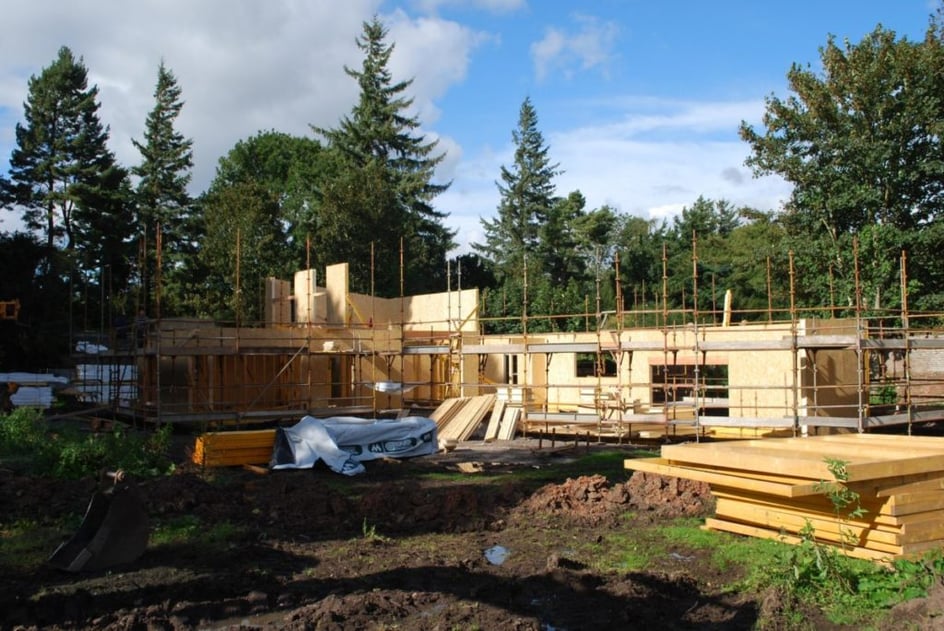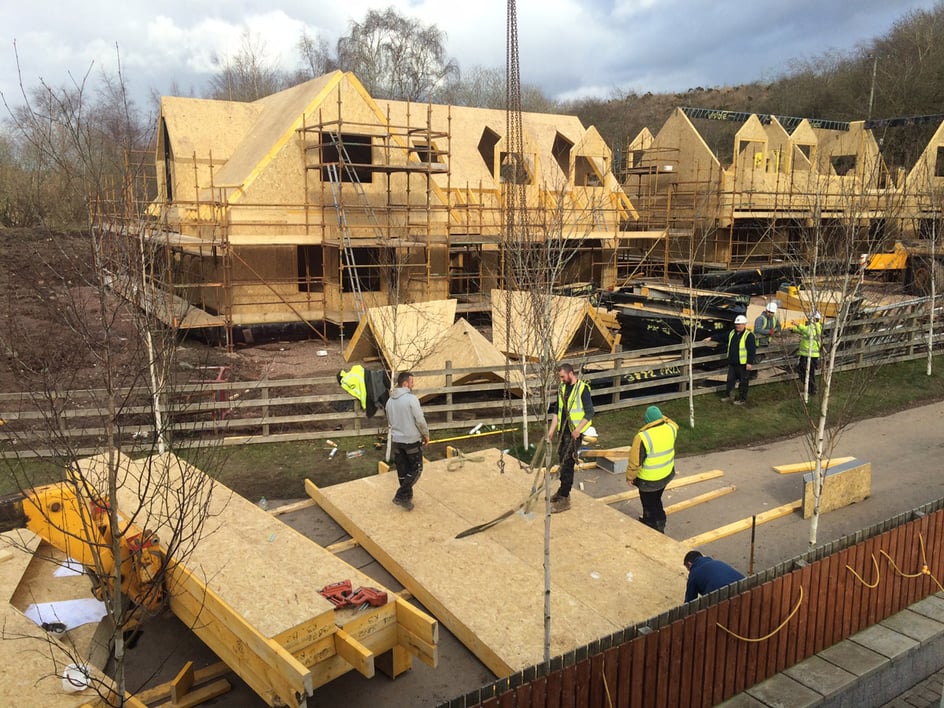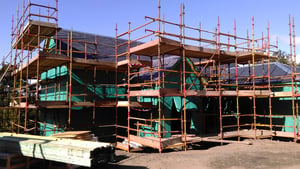We are a country becoming increasingly focused on combatting climate change, and reducing our carbon footprint is part of that focus. The construction industry is one of the biggest carbon culprits, with buildings emitting around 40% of global greenhouse emissions. New government regulations are being put in place as we gear towards reducing our carbon emissions and going Net-Zero by 2045 in Scotland.
We at AC Architects strive for sustainable and environmentally friendly construction, and the use of low-carbon methods helps us to achieve these goals. In this article, we’ll break down what it means to build homes with low-carbon methods, and why you should consider it at your earliest convenience.

THE INTRODUCTION OF LOW-CARBON BUILDING METHODS
The construction industry has been slowly shifting towards environmentally friendly methods for almost half a century. The early idealists saw that traditional methods were having an adverse effect on our environment. The global oil and fuel crises questioned the sustainability of the way our buildings were being erected. As the 21st century rolled around, the prioritisation of reducing our carbon emissions came further to the forefront.
Environmental concerns were not the only factor in moving towards low-carbon construction. Adopting construction methods that prioritised keeping emissions low began to bring down energy and maintenance costs as the building continued its life. Once the industry saw the long-term benefits, these methods took their rightful place at the front of the queue.
Modern-day architecture must follow strict codes and regulations to produce designs that are both healthy and safe for our environment. The International Green Construction Code (IgCC) is a good example of this. Self-build architects (such as ourselves), also work to make sure their homes meet new Passivhaus standards. Sustainable construction is becoming a necessity for self-build, both in environmental ethics and cost-cutting.
HOW WE DEFINE LOW CARBON CONSTRUCTION
When an energy source produces CO2, the emissions are released into the air. These emissions rise to our atmosphere where it then proceeds to trap heat, which slowly warms our planet. Burning coal is a good example of a carbon-heavy energy source.
For something to be low carbon, it would have to produce an almost insignificant amount of greenhouse gas. For something to be zero-carbon, it would produce no emissions.
When we describe a construction method as ‘low carbon’, we are referring to minimising the carbon footprint during the entire lifecycle of the building. From construction, occupation, and all the way through to demolition.
During a project, carbon emissions can come from an abundance of sources. A few examples include:
Material SelectionTransportation
Maintenance
Integrating Renewable Energy
Material Manufacture
Identifying and understanding the sources of carbon emissions in construction is the first step toward implementing sustainable practices. Through collective efforts, the construction industry can look towards lowering its carbon footprint.
Now, we all like doing our part to reduce our carbon footprint, but what benefits are these methods bringing to the prospective self-builder? Let’s break it down.
THE BENEFITS OF LOW CARBON CONSTRUCTION
Reducing our carbon footprint can bring a myriad of benefits to our self-build and our homes of the future. Here are the main examples.
Indoor Air Quality Improvement
The focus on sustainability extends to the indoor environment. Low-carbon building methods often incorporate features such as natural ventilation, abundant natural light, and the use of non-toxic materials. Not only does this enhance the quality of the air, but it creates a more inclusive environment for those with respiratory and allergy issues.
Higher Energy Efficiency
One of the primary benefits of low-carbon building methods is the emphasis on energy efficiency. Integrating features such as high-performance insulation, energy-efficient windows, and smart building technologies helps reduce energy consumption during a building's operational phase. By making energy efficiency a priority, the industry can curb emissions, helping to combat the global climate crisis.
Lower Energy Bills
A home with a higher energy efficiency will bring lower energy bills throughout its lifecycle. This saves the occupant a substantial amount in the long term and makes these more appealing to a self-builder.

Long Term Value
A home built with sustainability as a priority is a major incentive for both investors and buyers. Structures built using low-carbon methods have an enhanced market value due to their durable design. If it ever came to selling the home, the value would be a lot more than a home built with traditional means.
Creative Freedom
These methods may sound good on paper, but do they offer the same creative design freedom when compared to other methods? They do. In some cases, they can offer more design choices than other build methods. Modern methods also have no limitations regarding the outside look of the home. For example, a home built with a timber frame could accommodate a traditional brick finish.
Despite the long list of benefits low-carbon construction brings, the builder still has a higher upfront cost than a traditional method. Making this initial investment can prove a leap too far, which can scare away potential self-builders who don’t have the space in their set budget.
This is where an architect can help you. An architect can help you shape your budget to your needs while saving you money that would potentially go to waste.
Before going into any project, you should be educating yourself on the building methods that suit you, and where your materials would be sourced. Be conscious of the size of the build too, as a smaller build area means lower costs.
There are many construction methods to choose from, and picking the right one for you depends on your finances, planning permission, and design criteria. If cutting down your carbon footprint is a priority for you, think timber.
Any timber-based method will always bring low-carbon properties, due to the renewable nature of the material. During a tree’s growth, it absorbs carbon dioxide from the atmosphere and stores carbon within its fibres. When timber is used in construction, this carbon remains sequestered within the wood, effectively locking it away and preventing it from contributing to atmospheric greenhouse gas levels. This makes timber both a sustainable material, and a zero-carbon material.
A closed-panel timber frame kit with mineral wool insulation is our top pick at ACA for low-carbon construction. A more traditional wooden house, such as a Honka wood home, could also be a greater choice depending on your location.
HOW WE DO THINGS AT AC ARCHITECTS
We at Allan Corfield Architects believe self-builders can become leaders in low-carbon construction. Since our conception, we set out to provide self-builders with the tools they need to create sustainable homes. Almost 15 years and 500 projects later, we still have those same goals.
Conversations about your energy goals should be carried out as early as possible in the design process. The earlier these goals are set out, the more efficient the entire process will be. We have been working to incorporate low-carbon methods into our projects wherever we can, as the number of clients seeking carbon neutrality increases.
“In the last year, we’ve seen an increase in demand for solutions that are low carbon as well as low energy. Our clients are becoming more interested in all the aspects of sustainability.”
- Jenny Chandela, Associate & US-Registered Architect
If you have conducted your research into low-carbon construction methods, you are already on the journey to create a sustainable project. If you’re looking more for more information, we are always on hand to deliver expert advice on finding the best build method for you.
The journey towards sustainable construction is ongoing, but with each structure designed and built with low-carbon principles, we inch closer to a greener, more resilient world.
The benefits of low-carbon building methods extend far beyond the construction phase, influencing the long-term sustainability and environmental impact of our built environment. The construction industry is continuing to embrace these low-carbon methods, and that's how we are going to build homes that are good for the environment...and good for you.



